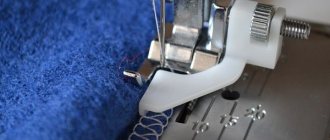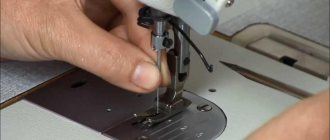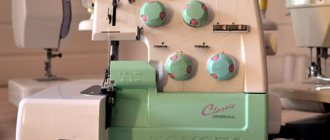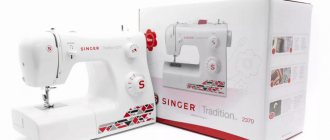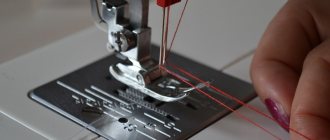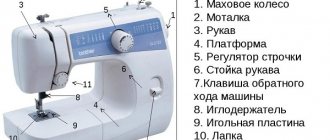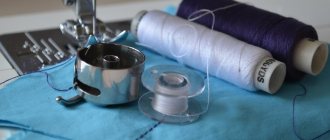What is the presser foot for?
The main purpose of the foot is to press the fabric to the table surface so that when the thread is pulled out, it does not move after it. On a regular household machine, the manufacturer installs a standard foot, with which any needlewoman can make the simplest seams.
But it is not suitable for all materials and not all sewing operations. For example, for sewing on buttons, creating pintucks, and high-quality work with knitwear, leather, very thin or very thick fabrics, you need to use special feet.
Blind stitch foot
Is there a quick and easy way to hem trousers and jacket so that the threads on the right side are not visible? Of course, if you use special feet for a hidden seam. There are several varieties of such paws. These presser feet allow you to create almost invisible hems: tiny stitches that are barely noticeable on the front of the garment, capturing just a few threads from the fabric structure.
There was a time when an invisible seam could only be done by hand. But currently this is not the case. And if you use clear top thread, the stitching will be even harder to spot.
Let us know in the comments if you would like detailed master classes on the functionality of sewing machines, types of stitches and sewing tricks.
Thank you for your attention and see you again!
What types of paws are there and what are they used for?
Many modern models of household machines are adapted to work with a wide range of sewing feet. In addition to the standard one, the set of accessories usually includes a basic set of several pieces. Their number varies depending on the model of the machine, its cost and manufacturer.
Some models have only 5 pieces, while others have up to 14. You can purchase additional special devices as needed during the operation of the machine.
This accessory can be made of different materials: metal, high-quality polymer, transparent plastic, which largely depends on its purpose. Let's look at the types of feet most used by modern craftswomen.
Standard
All sewing machines are equipped with a universal foot. It is designed to perform two main seams: straight and zigzag with the ability to change the length and width of the stitch. Most needlewomen use only this foot for all sewing situations.
Walking
Designed to ensure uniform feeding of material using a special comb, it does not allow layers to shift on very thin or thick fabrics, including a blanket or down jacket.
The walking foot is also called the upper feed. Helps promote the product not by sliding, but by moving movements.
For bias tape
Allows you to create bias binding with even seams equally spaced on both sides of the edge in one pass.
The snail in the design wraps the fabric and guides it in front of the needle. For different widths of binding, different presser feet are used. If there are several slots of different sizes in the snail, then it is possible to sew on trims of different widths.
For lightning
The zipper foot helps to make an even seam at the same distance from the edge of the zipper without turning the product. Such devices can be single-sided, double-sided, narrow, or for a hidden zipper.
They also differ in the material from which they are made: metal, plastic, Teflon.
For buttons
Using this device, flat buttons with holes are sewn with a zigzag seam at a distance from each other no more than the maximum seam width for a given machine model. The design has rubberized linings so that the buttons do not slip.
Sewing is performed at slow speed with the lower conveyor turned off. Before sewing, you need to make sure that the zigzag distance is set correctly, otherwise the needle will break.
Podrubnaya
It is also called a hemmer, a chopping foot, or a twisting device. It has a curling device and, in one pass, folds the edge of the product in half and sews an even seam without first ironing the folded edges. Can perform hems to different widths.
Knitted
Elastic fabric, such as knitwear, stretch, has the ability to stretch when sewing seams as usual. For an even, beautiful stitch, a knitted foot is required that prevents the material from hanging down and clogging between the teeth of the lower conveyor. It prevents stitch skipping and tearing.
To create tucks
Pintucks are created by sewing with a double needle using a special foot. They are obtained on the product thanks to the grooves on its sole. There can be up to 9 pieces. depending on the model.
The height and thickness of the fold depends on the depth of the grooves. Can be used to create pintucks with insert cords.
For quilting
To stitch the scraps together and embroider them on sewing machines, you can buy a quilting device. With its help it is good to do darning and stitching, to make seams at a given distance and at a certain angle.
That's why these paws are different. For a variety of stitches, you can buy a whole set.
For assemblies
Designed for making soft gathers and flounces of the desired size. The device has two mechanical adjustments, thanks to which you can perform complex assemblies with rarer or more frequent folds. To create gathers, the sole is raised behind the needle and has a thickening in front of the needle. She gathers one fabric in one pass and sews it to another.
For a narrow hem
The design of such a device has a curl that bends the edge in half and immediately creates a beautiful and even seam. Used for thin and delicate fabrics such as chiffon. Does not allow edges to fray. Can be used to process the edges of scarves, shawls, napkins, and household items.
For parallel lines
The foot is made of transparent plastic and has markings that allow it to sew parallel decorative stitches. First, one line is laid. Then it is placed between the red guides on a transparent sole and the second line is sewn parallel to the first.
Teflon
Not found in the standard set. The Teflon foot is designed for working with high-density fabrics. Made of a special polymer that allows you to glide easily when working with leather, suede, velvet, vinyl, and does not cling to the material. Works smoothly and leaves no marks. Does not cope with slippery fabrics.
With limiter
Used for making neat finishing stitches with a uniform indentation from the edge, as well as for wasting products, processing cuts and making a blind seam. Allows you to make standard and decorative seams.
Roller
Used for sewing thick fabrics: leather, suede, corduroy. The roller does not put pressure on the material, displacing it, but easily rolls over uneven layers of fabric, where the seams meet. The roller foot is also used for making decorative stitches; it can make not only straight seams, but also zigzag ones.
Overedge
Helps to overcast the bottom of the material with an even overcast stitch, preventing it from deforming. During operation, several stitches are placed on the tooth located in the center of the needle slot. They come off as the fabric moves and form an even overcast seam.
How is it different from a standard presser foot?
The universal presser foot is installed on most household sewing machines. This foot presses the fabric against the needle plate, and during the sewing process, the bottom layer is advanced by the toothed rack located below. The top layer of fabric moves due to adhesion to the bottom layer, while the presser foot slightly slows down this movement.
Therefore, when using a standard presser foot, the top layer of material always moves slower than the bottom layer. This leads to shifting of the pattern pieces, which is especially noticeable on heavy and super light fabrics.
Unlike the presser foot, the walking model has a toothed upper feed that “picks up” the top fabric and advances it simultaneously with the bottom layer. Thanks to this, the layers of material move at the same speed, and the stitching is perfectly even, without displacement or distortion.
Tips for choosing sewing machine feet
When choosing an accessory, you need to remember that not all paws fit all car models. Therefore, you need to read the list of models, which is in the description of the selected accessory. You should pay attention to the criteria by which presser feet of one brand may not fit a sewing machine from another manufacturer. This:
- fastening method;
- distance from the attachment point to the needle hole;
- height of the foot from the base to the fastening;
- zigzag width;
- the location of the attachment point in relation to the center of the device.
After this, you can go purchase new paws and do not neglect the advice of the seller.
How to choose an upper conveyor
When purchasing a walking foot, you must first make sure that the models of the accessory and the machine match. A foot designed for a machine with a 9mm zigzag width will not fit a machine with a 5mm zigzag width. Pay attention to the information in the model description or check the branded accessories catalog of the manufacturer of your sewing machine.
For some upper conveyors, various soles are available (some models are equipped with them):
- open type, which will provide greater visibility around the needle;
- for straight stitch and zigzag;
- for quilting and split stitching;
- with a guide for precise stitching indentation.
How to use
It's not enough to just change the presser foot, you need to know how to use it. There are some that do not require additional manipulations with devices to use. The fabric is placed on the lower conveyor. The sole is lowered onto the material and you can start sewing. In this case, the seamstress can move and hold the product with her hands in a certain way. It depends on the type of sewing operation.
But there are devices with a complex design, into which you need to tuck the main fabric or finishing material in a certain way. Here are examples:
For a narrow hem, cut the edge of the fabric at an angle of 450 and tuck it into the hem hole.
For tucks, you need to insert the tuck into the notch on the bottom of the sole to guide the next fold.
For bias tape, cut off the corner of the tape and insert the resulting point into the snail, pulling it out behind the paws; place the material for the edging in the cutout on the device.
How does a walking foot work?
Walking feet are usually made of metal with individual elements made of durable polymer (some models can be completely metal). The design of the upper conveyor consists of 3 main elements:
- mini-case made of plastic - elements of the working mechanism are “hidden” in it;
- a presser foot with lower toothed racks (when sewing, they move up and down, advancing the fabric);
- a control lever with a special fork at the end (it is attached to the needle holder screw).
Above the foot there is a special leg with which the walking conveyor is attached to the rod of the presser foot. There are holes on the body for a guide - this is an additional element in the form of a metal pin. It provides even, parallel lines. May be included with the foot or sold separately.
Expert opinion
Alexandra Vilisova
Experienced seamstress
Walking feet may differ in external design, material and zigzag width (5-9 mm). But the operating principle is the same for all types of upper gear conveyors.
How to change
Replacing the accessory is easy. Depending on the manufacturer, the mounting method may vary slightly. Most modern machines have a standardized holder. There are two main ways to change presser feet of different configurations.
Replacing only the sole
To do this, lift the foot and needle up and press the lever located at the back of the device. The sole will come off immediately. Place the new one under the holder, lower the rod into the socket of the sole. A characteristic joining sound will follow.
Zipper foot
Most machines come with a zipper foot. This foot slides along the side of the zipper and allows you to sew much closer to the zipper teeth than with a standard foot. Depending on the design of the foot, it can be attached on the right or left side, allowing you to quickly and easily sew both sides of the zipper.
Buttonhole foot
A buttonhole foot is also included as standard on most machines. These feet allow you to make holes for buttons of different diameters without worrying that one loop will be longer and another shorter. Depending on your sewing machine, you can either program the desired buttonhole length, or place the desired button in the foot and thereby set the desired hole length.
Tips for choosing
When choosing feet for sewing machines, it is worth remembering the main thing: accessories for household models and professional equipment have significant differences. You should not choose the first set or individual components you come across without clarifying this point. In addition, the paws must be compatible with the equipment of a particular manufacturer. Many brands prefer to produce components for their cars themselves and do not recommend using non-standard parts.
If you want to get sewing equipment with a wide range of default options, you should immediately pay attention to the package. The wider it is, the fewer accessories you will have to buy . Conveyors made of Teflon and plastic most often have highly specialized applications. They are not worth purchasing for everyday sewing. It is necessary to take into account that accessories for working with decor most often have to be purchased separately ; it is quite difficult to find a device for working with beads or embroidery as standard.
